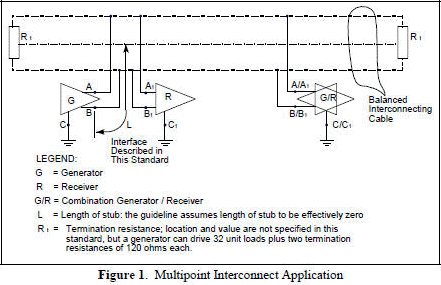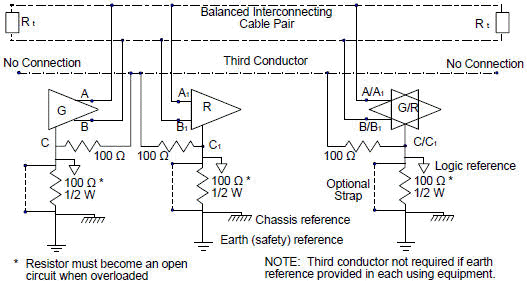Electronic Warfare and Radar Systems Engineering Handbook |
|||||||||||||||
|
RS-485 INTERFACE STANDARD FOR ELECTRICAL CHARACTERISTICS OF GENERATORS AND RECEIVERS FOR USE IN BALANCED DIGITAL MULTIPOINT SYSTEMS
Introduction: The RS-485 is the recommend standard by the Electronic Industries Association (EIA) that specifies the electrical characteristics of generators and receivers that may be employed for the interchange of binary signals in multipoint interconnection of digital equipments. When implemented within the guidelines, multiple generators and receivers may be attached to a common interconnecting cable. An interchange system includes one or more generators connected by a balanced interconnecting cable to one or more receivers and terminating resistors.
General System Configuration: The generators and receivers conforming to the RS-485 standard can operate with a common mode voltage between -7 volts and +7 volts ( instantaneous ). The common mode voltage is defined to be any uncompensated combination of generator-receiver ground potential difference and longitudinally coupled peak noise voltage measured between the receiver circuit ground and cable with the generator ends of the cable short circuited to ground, plus the generator offset voltage (Vos). Grounding Arrangements: Proper operation of the generator and receiver circuits requires the presence of a signal return path between the circuit grounds of the equipment at each end of the interconnection. The grounding arrangements are shown in Figure 2. Where the circuit reference is provided by a third conductor, the connection between circuit common and the third conductor must contain some resistance ( e.g., 100 ohms ) to limit circulating currents when other ground connections are provided for safety. Some applications may require the use of shielded interconnecting cable for EMI or other purposes. The shield shall be connected to frame ground at either or both ends, depending on the application.
Figure 2. Grounding Arrangements Similarity with RS-422-A: In certain instances, it may be possible to produce generators and receivers that meet the requirements of both RS-422-A and of RS-485. Table 1 depicts the differences in parameter specifications which exist between the two documents.
Table 1. Comparison of RS-422-A and RS-485 Characteristics
Where tb = time duration of the unit interval at the applicable data signaling rate (pulse width
Table of Contents for Electronics Warfare and Radar Engineering Handbook Introduction | Abbreviations | Decibel | Duty Cycle | Doppler Shift | Radar Horizon / Line of Sight | Propagation Time / Resolution | Modulation | Transforms / Wavelets | Antenna Introduction / Basics | Polarization | Radiation Patterns | Frequency / Phase Effects of Antennas | Antenna Near Field | Radiation Hazards | Power Density | One-Way Radar Equation / RF Propagation | Two-Way Radar Equation (Monostatic) | Alternate Two-Way Radar Equation | Two-Way Radar Equation (Bistatic) | Jamming to Signal (J/S) Ratio - Constant Power [Saturated] Jamming | Support Jamming | Radar Cross Section (RCS) | Emission Control (EMCON) | RF Atmospheric Absorption / Ducting | Receiver Sensitivity / Noise | Receiver Types and Characteristics | General Radar Display Types | IFF - Identification - Friend or Foe | Receiver Tests | Signal Sorting Methods and Direction Finding | Voltage Standing Wave Ratio (VSWR) / Reflection Coefficient / Return Loss / Mismatch Loss | Microwave Coaxial Connectors | Power Dividers/Combiner and Directional Couplers | Attenuators / Filters / DC Blocks | Terminations / Dummy Loads | Circulators and Diplexers | Mixers and Frequency Discriminators | Detectors | Microwave Measurements | Microwave Waveguides and Coaxial Cable | Electro-Optics | Laser Safety | Mach Number and Airspeed vs. Altitude Mach Number | EMP/ Aircraft Dimensions | Data Busses | RS-232 Interface | RS-422 Balanced Voltage Interface | RS-485 Interface | IEEE-488 Interface Bus (HP-IB/GP-IB) | MIL-STD-1553 & 1773 Data Bus | This HTML version may be printed but not reproduced on websites. |
|||||||||||||||

